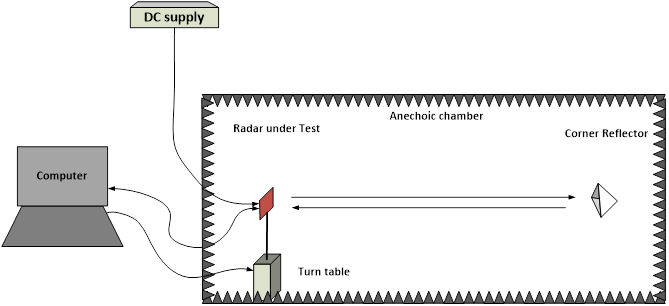SPRACX7 April 2021 AWR1243 , AWR1443 , AWR1642 , AWR1843 , AWR1843AOP , AWR2243 , AWR2944 , AWR6843 , AWR6843AOP , IWR1443 , IWR1642 , IWR1843 , IWR6443 , IWR6843 , IWR6843AOP
2.1 Hardware
The hardware for testing Radar is shown below. It comprises of the following components:
- Anechoic chamber with turn-table
- Corner reflector
- DC supply with ammeter
- Computer for data & control interface to the Radar unit and also for controlling the turn-table
 Figure 2-2 Hardware for Basic Radar Testing
Figure 2-2 Hardware for Basic Radar TestingThe width and height of anechoic chamber can be typically with W ˟ H = 60 cm ˟ 60 cm. The length of the chamber should be such that the corner reflector can be placed well in far-field zone. The formula given below can be used to calculate the far-field zone.
Minimum Far-field distance, d = 2.D2 / λ
Where D is the maximum dimension of the antenna array,
λ is the wavelength of the signal in air.
For example, a radar designed using a single mmWave sensor operating in 76-77GHz band with an antenna array that spans 24 mm will have d = 295 mm. After allowing space for turn-table and corner reflector and cabling, a 60-cm long chamber should suffice to test this Radar.